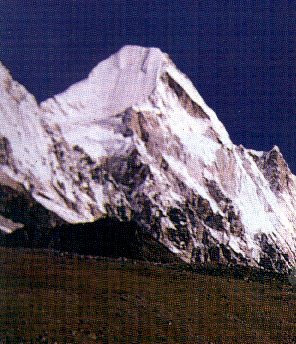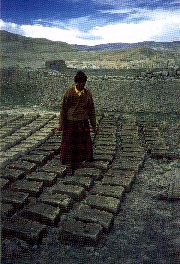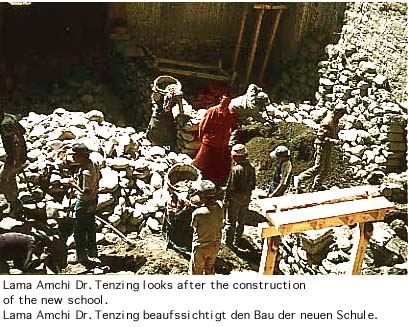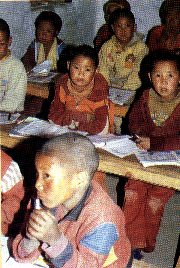_________________________ _________________________
_________________________
_________________________ _________________________
_________________________
![]()
![]()
![]()

![]()
![]()
The world is changing rapidly today - more than at any other time of recorded history. As
more technical and industrial changes take place there arise new values and new culture, which
replace old  and valuable ancestral heritage
in many parts of the world, and nowhere more so than in Asia, and the Himalayan region in particular.
and valuable ancestral heritage
in many parts of the world, and nowhere more so than in Asia, and the Himalayan region in particular.
The socio-economic development that is occurring so fast in the wake of technological innovation has caused us to forget our ancient glories, while having failed to reduce human suffering. We thus, unfortunately, still have many forgotten remote areas inhabited by many forgotten people who have no access either to social welfare, health facilities or education. These are the people who are deprived of all privileges in our modern society. It is our duty to stand by the poor, the disabled, the needy, the young and the aged. If we can bring a few rays of sunshine to the hearts of these people, it will be a great achievement.
With a view to standing by the destitute, be they children, women, the aged, orphans or others and to alleviating their problems and thereby raising their socio-economic status by way of initiating health, education and income-generating programmes, I have founded an institution called HimalAsia Foundation, headquartered in the Federal Republic of Germany.
Drying mud-bricks for construction of a new medical building for the Amchi Lama (Doctor of Tibetan Medicine) in Lo Manthang
__________________________________________________________________________
______________________________________________________________________


RATIONALE
People who are living in a condition beneath human dignity do not need mercy but rather a minimum degree of outside cooperation so as to enable them to support themselves on a more equal footing with their more educated and resourceful fellow human beings. Support from the latter to people subsisting below the poverty line should be an act of duty, not one of charity. It is with these ideals and principles in mind that I have ventured to establish this foundation, HimalAsia, as a matter of absolute urgency.

Newly roofed Gompa in Upper Mustang, Nepal
QBJECTIVES AND PROGRAMME
One of the targets of HimalAsia is to initiate small schools and promote existing schools in educating children in their own cultural setting particularly in remote areas. HimalAsia does not believe in merely pushing all students towards higher academic fields. Its more pressing aim rather is, to keep alive the old manual skills and craftsmanship of highly cultured peoples, whose ancient skills have been admired worldwide up to this day. By means of such efforts HimalAsia also aims to create measures for income generation. Furthermore, it intends to foster a new approach to instilling old values, namely by encouraging and reintroducing old traditions such as religious worship, socio- religious feasts and annual events and celebrations. HimalAsia hopes to raise the standard of living among low- and middle-income groups by showing them ways to make use of the broad spectrum of their capacities and then giving them the chance to do so to their own benefit.
One very important area that HimalAsia will stress is the development of women's skills and women's health care along with the promotion of women's activities. Women are the backbone of society, and, therefore holding them in high respect and appreciating their achievements are of utmost importance.

HimalAsia will also try to support an institution for parentless children and children whose
parents are incapable of supporting them, in order to provide them with access to educational
opportunities  and a share in
global society. This means that they must be offered a place within a family setting in a village
or social community rather than exclusively being brought up in an orphanage house.
and a share in
global society. This means that they must be offered a place within a family setting in a village
or social community rather than exclusively being brought up in an orphanage house.
I emphasize very strongly therefore, that HimalAsia and its Associates will invest their utmost energy in such social activities as:
creating schools and manual training centres
creating orphanage houses in supportive surroundings
creating houses for old people
creating local medical institutions and health centres
creating children`s daycare centres and preschools
all these, particularly, in remote areas.
Man does not live alone from bread or water. No one is properly human without his or her culture. Therefore HimalAsia and its Associates should not only direct their efforts towards social activities but also think of mankind's roots and the ancient cultures sprung from them which contain a rich fund of wisdom, experience and tradition in many fields of endeavour - all of utmost importance for the life of the entire human race, in that it provides sources of identification. These need to and can still be protected and revived by documenting them in cooperation with living and knowledgeable older men and women, and by collecting material culture or photographs, paintings and drawings. One should study these thoroughly and encourage men of letters at universities and other such institutions to do so as well.
The regions I am thinking about are: the Himalayan area and Central, South and South-East Asia. Here there are very important and interesting fields of lore, both tangible and intangible, which must be saved, such as ancient Vajrayana Buddhist narrative wisdom (shruti), shamanistic knowledge, epic narratives, rituals and healing techniques, and other oral traditions directly linked to life settings, as well as art and craftsmanship.
If we cannot do something in the very near future, much important and precious knowledge and culture will disappear irretrievably for ever. This ought to awaken our sense of responsibility towards our world and mankind. We must try to do whatever is possible, and work swiftly and effectively.
Time is running out for many of the world's cultural treasures. It is high time to coordinate national and international efforts in order to save the many endangered cultural objects and monuments all over the globe. Increasing ecological problems, military conflicts, arbitrary political acts, large-scale technological projects and excessive international tourism represent acute threats.
Especially affected are developing countries, in which a great portion of the outstanding tangible and intangible cultural heritage is located. In these countries, well represented in the Himalayan area and Central, South and South-East Asia, there is a pronounced lack of expertise in conservation and restoration, and in how to meet the demand of preserving and documenting intangible heritage.
Among the devastating threats facing our planet are ecological catastrophes resulting from human intervention in nature. Not only wars but environmental pollution, natural disasters, deforestation and the exploitation of resources endanger its survival for future generations. In order to counteract this threat HimalAsia will endeavour to raise ecological awareness - for example, by planting trees in deforested regions - while at the same time encouraging the restoration of moribund culture, since the conservation of either the natural or cultural environment often has positive effects on the other (i.e., culture or nature). Culture and nature are both part of one system, and in many cases can only be revived simultaneously, in an attempt to keep the whole system alive.
This appeal reaches out to people of similar understanding, and if you are one of them, I would like to request as much support as you can offer in order to achieve the goals which we are aiming at.
We are confident of being able to help mankind to better the conditions of life. Therefore we shall strive towards the goal that human beings may be able to achieve the best for their life and cultural development.

Zongsar Ngari Chödje Tulku
T.T. Thingo Rinpoche
The late Chairman of HimalAsia
___________________________________________________
|
Exhibition at Unesco Headquarters in Paris in Cooperation with HimalAsia "Health Futures / Zukunft Gesundheit" Nepal`s Medieval Heritage of Painting From Malla Period to Rana Time. |
EXPO-Projekt HimalAsia vorgestellt im Themenpark in Hannover "Zukunft Gesundheit" Traditional Herbal Medicine Clinic and School in Mustang "Health Futures / Zukunft Gesundheit" Nonnenschule in Tsarang, Nordmustang, Nepal Erhalt des Natur- und Kulturerbes |
___________________________________________________
HIMALASIA - Cultural Heritage and Educational Foundation
Durga Bhawan, Bhat Bhateni
Kathmandu, Nepal
Tel. / Fax: (009771) - 419559
___________________________________________________
ZONGSAR NGARI CHÖDJE TULKU
Gumpa Residence, Orchid Htl., National Hwy
Gangtok 737101
Sikkim (India)
Tel: (0091)- 3592-23746
___________________________________________________
ZONGSAR NGARI LABRANG
Haus Trettin
Spreitger Weg 20, D- 51588 Nümbrecht, Germany
Tel / Fax: (0049)- (0)-2293- 4935
.
Konto:
HimalAsia, Commerzbank Koeln
IBAN: DE 14 37040044 0185 884400
BIC: COBADEFF370
.
![]()
.___________________________________________________
.
webpage created by Beate Freihold